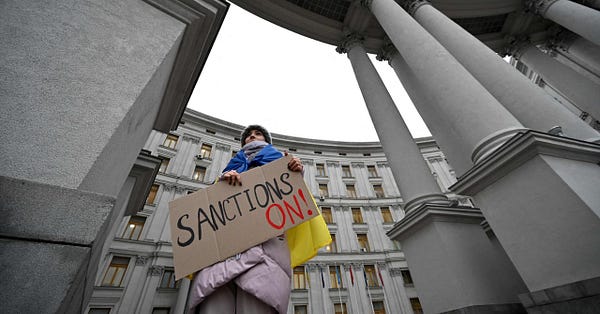Analyzing Intelligent Warfare, NSA Backdoor in Chinese Systems, Russia-China's Alternate International Payments System
Issue 20, 28 Feb 2022
Hey,
My colleague Manoj Kewalramani and I have written an analysis on China's perceptions and interests in Ukraine conflict. Read our full analysis here.
Also, my article on implications of excluding Russia from SWIFT was published by Deccan Heard. I have included an excerpt and link to the article in SinoSync section.
Happy Reading!
I. Military and Warfare
"si vis pacem, para bellum" (If you want peace, prepare for war) - From Epitoma Rei Militaris (De re militari) by Vegetius (Roman military general)
Analyzing Intelligent Warfare
This week's article in PLA Daily by Zhao Xiangang, Zhou Yibin, and Li Bohan (affiliation not given) is about analysing intelligent warfare.
Supported by cloud (云联支撑的作战体系)
The information-based combat system is based on the network information system, while the intelligent combat system is supported by the combat cloud. The combat cloud can organically reorganize the deployed combat resources to form an elastic and dynamic combat resource pool. Features of such combat could include virtualization, connectivity, distribution, easy expansion, and on-demand services. These can be obtained for each combat unit on demand.
Integration of battlefield resources: Combat Cloud would enable connection of information and physical systems with IoT. This will enable integration of battlefields resources across land, sea, air, space, electronic, and cyber/network domain (cross-domain integration). (通过配置在不同层级和不同规模的作战资源云,高度共享陆、海、空、天的多维作战数据,实现陆、海、空、天、电、网等作战域的战场资源整合,使各种作战要素汇集成云,完成战场数据的网状交互。)
Enable joint operations: Combat systems supported by cloud will enable integrated information processing of joint operations with help from technologies like big data and cloud computing. It will also help to distribute battlefield intelligence across various domains.
How will this help on battlefield?
Interpret and evaluate multiple intelligences Battlefield situation
Optimization of combat plan
Determination of combat
Preparation of combat plan
Regulation of troop actions
Efficient scheduling and control of the combat system
It can quickly and flexibly adjust, optimize configuration and regroup online, form an adaptive task force
Implement decentralized energy-gathering operations
Dispersed and focused battlefield deployment (分散聚能的战场布势)
A joint combat system can deploy forces in a decentralized manner, quickly switch tasks, and dynamically aggregate effectiveness to achieve In response to complex and changeable battlefield situations. The force formation in intelligent warfare is different from that on information-based warfare.
The decentralized and concentrated battlefield deployment enables commanders at all levels to quickly and efficiently conduct in-depth perception and accurate prediction of the battlefield situation through the intelligent command information system's big data analysis, battlefield situation collection, multi-source intelligence verification and other auxiliary methods.
How will this help on battlefield?
Predict the situation and issue early warnings
Enable various combat forces and combat units deployed in a wide area and flexibly configured to respond in a timely manner according to the predetermined combat plan or the need for ad hoc coordinated operations
Quickly gather and disperse
Dynamically focus on combat effectiveness
Focus on key nodes of the enemy's combat system and high-value targets related to the overall strategic situation at critical time and space
Quickly form system combat advantages, and through a highly resilient, networked kill chain
Improve the combat effectiveness
Human-machine fusion command and control (人机融合的指挥控制)
Human-machine fusion command and control can bring out advantages of human brain and machine intelligence under the support of rational division of labour between human-machine functions and efficient decision-making of human-machine interaction. "Cloud Brain", can carry out intelligent auxiliary decision-making, command and control and evaluation and deduction, combine "human strategy" and "machine strategy". Article also mentions some other applications very similar to the ones mentioned in previous subheadings.
Also read this different article by Zou Li (affiliation unknown) outlines three levels of human-machine collaboration. The author divides human-machine collaboration as
System-based human-machine marshalling (基于体系的人机编组)
Task-based human-computer collaboration (基于任务的人机协同)
Goal-based human-machine division of labour (基于目标的人机分工)
Autonomous and coordinated combat operations (自主协同的作战行动)
Authors argue that implementing autonomous operations is an important operational principle and requirement for commanders at all levels to seize fighter opportunities, adapt accordingly and act quickly on the ever-changing battlefield, gain advantages, and keep the enemy from moving. With the continuous development of technology, autonomous collaborative operations will become the most common collaborative form of future intelligent operations.
Features expected from such autonomous and coordinated combat operations:
Intelligent processing system
On-demand extraction of information resources
Flexible and fast organizational support
Research and judgement system that can act with little or no reliance on the control of the superior command organization
Grasp information on changing situation on battlefield
Organize combat and coordinate actions
Automatically completes OODA cycle
Can identify friends and foes
Autonomously track targets
Autonomously and flexibly select mission loads
Autonomously carry out attacks within the authority granted by the operator
Intelligent weapon systems in different spaces can form a combat power generation link of "situation sharing-synchronization-cooperation-gathering and releasing energy" with the development of the battlefield situation and operational needs
Managing National Defence Mobilization in wartime
This article in PLA Daily talks about national defence mobilization operation management in wartime.
Requirements and features of mobilisation in modern times are as follows:
Highly political and requires strict behaviour control. This is especially true in era of informatization and intelligence since most national defence mobilization actions will become be scrutinized by live media.
The power is often dispersed and makes organization and coordination difficult during wartime. Hence, effective coordination among local military leadership, command agencies, combat troops training, force management, and combat service planning, and involve local governments, and others involved in wartime efforts.
Urgent and fast paced management is required. In informatized and intelligent operations, the combat rhythm are significantly accelerated, and the action cycle are significantly shortened. Hence, emphasis of urgency and pace.
Complex environment and heavy security risk. Wartime national defense mobilization operations under modern conditions have increased the use of large-scale machinery and high-end professional technical equipment, long maneuvering distances, unfamiliar and dangerous geographical environments, complex climate and natural conditions, increased insecurity factors, and security risks, etc.
I am not sure if this article was written considering situation in Ukraine-Russia. However, given the publicity and scrutiny Russian mobilisation on Ukraine border got days before Russia decided to take military action in Ukraine, this is certainly an interesting reading on how PLA writers view defense mobilisation in modern era.
Also Read:
II. SinoSync
Chinese Security Experts Discover NSA Backdoor in Chinese Systems
Chinese cybersecurity firm Pangu Lab (盘古实验室 Pángǔ shíyàn shì) released a report on Feb 23 claiming they have discovered a backdoor in Chinese systems attributed to National Security Agency (NSA) of the United States (US).
Pangu Lab has named this Advanced Persistent Threat (APT) backdoor as Bvp47 (Telescreen). The detailed report named "Equation" group affiliated with NSA as the preparator. The report is available in both English and Chinese. Zichen Wang has also provided a good summary of this incident in Pekingnology.
The report also claims that 287 important industrial institutions and systems in 45 countries have been targeted. Targeted countries include China, India, Russia, Japan, Germany, Spain, UK, Italy. Japan was allegedly used as a springboard to carry out these operations. The countries have been monitored for a decade. While details of systems attacked in China are not given in report, those targeted in other countries are given, including those in Taiwan. Interestingly, many institutions targeted appear to be universities and educational institutions.
14 domains attributed to India are also on the list of victims of this backdoor. Targeted institutions in India include Banaras Hindu University, India Education Network, Eureka Technology Partners, Indian Academy of Sciences, Indian Institute of Tropical Meteorology, Council of Scientific & Industrial Research (CSIR) – Institute of Microbial Technology (IMTech) among others.
Global Times claimed that this is the first time a Chinese cybersecurity firm has exposed a complete chain of technical evidence about APT attacks.
Pangu Lab (full name - Beijing Qi'an Pangu Laboratory Technology Co., Ltd.) is based on a well-known cybersecurity research team called Pangu Laboratory. The firm was apparently established just a few days ago as per the notification on the website.
Similar reports of Chinese hackers targeting American and other institutions around the world are always published and widely discussed. Hence, a Chinese report exposing American hacking was probably overdue. As also noted in Pekingnology, Hu Xijin, former Editor-in-Chief of Global Times had expressed on his WeChat blog that there is no Chinese expośe of foreign cyberattacks on China. Hu Xijin posted this on his WeChat blog on Feb 21 and Pangu Lab released its report on Feb 23. That’s quite a coincidence I must say.
Also Read:
Sanctions on SWIFT Could Bring Russia-China Together to Build an Alternate International Payments System
This is an excerpt of my article published by the Deccan Herald. Read the full analysis here.


On Feb 24 the United Kingdom (UK) announced its “largest ever” economic sanctions on Russia and so did the United States (US). As the sanctions get stricter, common economic interests and geopolitical considerations are likely to deepen economic relations between Beijing and Moscow, including prospects of building an alternate financial system.
Stricter financial sanctions were expected after Russia marched into Ukraine and started bombing Ukrainian cities. British PM Boris Johnson has also made a bid to push Russia out of the SWIFT international payment system widely used by banks all over the world. Such sanctions were also speculated during the 2014 Crimean crisis. If America and Europe agree to cut Russia out of SWIFT, it could seriously damage Moscow’s international trading capabilities. Exclusion from the international financial system could compel Russia and China to build an alternate financial system to the Brussels-based SWIFT payments system. Iran was once cut off from the SWIFT system. However, Russia will be the first major country to be cut off.
Foreshadowing the possibility of stricter economic sanctions, Russia has already started building its alternate payment system called SPFS. Similarly, in 2015 China also launched its own version of payments systems called Cross-Border Interbank Payment System (CIPS) to internationalize the use of Yuan. Both countries are also exploring options to adopt these alternate models in their respective banking systems. Although both systems are in the nascent stage of development and not as widely accepted as SWIFT, it indicates Moscow and Beijing's recognition of the need to come together amidst the threat of exclusion from the international financial system. Beijing’s efforts to promote digital Yuan (e-CNY) are also supposed to bolster its ability to facilitate cross-border payments. Already being tested in around 10 regions of China, the testing of e-CNY was also launched for foreigners during the Beijing Winter Olympics.
Move to build an alternate international payments system similar to SWIFT would be rooted in realism. Both countries have emerged as rivals of the West in Europe and the Indo-Pacific respectively. Both countries have faced numerous sanctions over the last few years. Both countries know sanctions may only get stricter over time. Thus, it is prudent and won’t be unexpected if Beijing and Moscow stick together despite differences in their worldview. Moreover, even though there is an imbalance in Russia and China’s economic relationship already, Moscow has very few options but to strengthen its relations with China.
Also Read:
Ukraine conflict: What is Swift and why are leaders divided on banning Russia?
US didn't cut off Russia from SWIFT to prevent unwanted consequences
III. Before You Go
Sharing highlights of my podcasts and research projects from this week.
Takshashila Research Note – Analysis of Chinese Perceptions and Interests Amid the Ukraine Conflict


Can war and ethics go hand in hand?


Discussion on US’ Indo-Pacific Strategy


Megha Pardhi is a Research Analyst at The Takshashila Institution. She tweets at @pardhimegha21.



